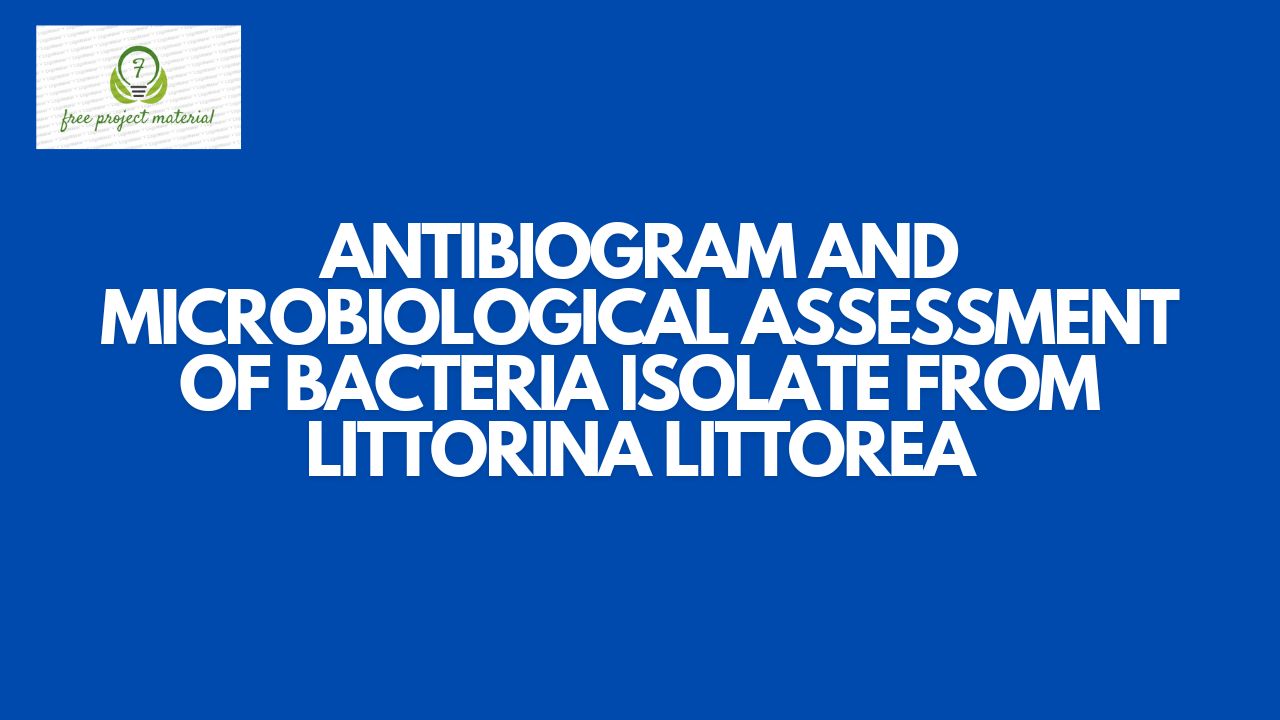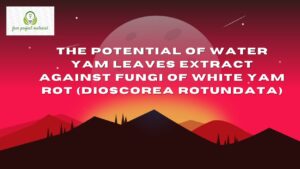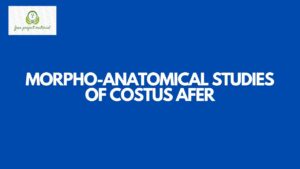ABSTRACT
Antibiogram and microbiological assessment of bacteria isolated from Littorina littorea. The study was subjected to the assessment of microbiological and antibiotics sensitivity test of the discovered pathogens, Staphylococcus sp, Klebsiella sp, Enterococcus sp, Enterobacter sp, and Bacillus sp. The total bacterial colony count was 17.0×104 and the total fungal colony count was 1.2×104 respectively, and biochemical test was carried to further identify each of the bacterial isolates, Staphyloccocus had the highest frequency and percentage of occurrence of 12(30.77%), followed by Enterobacterium sp 9(23.08%), Bacillus sp 8(20.51%), Klebsiella sp 6(15.38%), and Enterococcus sp 4(10.26%) and the fungal isolates revealed Saccharomyces sp had the highest frequency and percentage occurrence of 3(50.0%) followed by Clandosporium sp 2(33.3%) and Geotrichum sp 1(16.7%). In the antibiotics sensitivity testing Klebsiella sp had the highest percentage resistance with 60% followed by Enterobacter sp. 55%, Staphyloccocus sp 50%, Bacillus sp.30% and Enterococcus sp 40%.
TABLE OF CONTENTS
Title page – – – – – – – – – i
Certification – – – – – – – – ii
Dedication – – – – – – – – – iii
Acknowledgement – – – – – – – iv
Abstract – – – – – – – – – v
Table of Contents – – – – – – – – vi-xi
CHAPTER ONE: INTRODUCTION
1.1 Background of the study – – – – – – 1-4
1.2 Aim and Objectives of the study- – – – – 4
1.4 Scope and Limitation of the study – – – – 5
CHAPTER TWO: LITERATURE REVIEW
2.1 Scientific Classification of Littorina littorea- – – – 6
2.2 Description of Littorina littorea- – – – – 7-8
2.3 Ecology of Littorina littorea – – – – – – 8
2.3.1 Habitat- – – – – – – – – 8
2.3.2 Feeding- – – – – – – – – 9
2.3.3 Life Cycle- – – – – – – – – 10-11
2.4 Uses of Littorina littorea – – – – – – 11-13
2.5 Bivalves contamination and their risk of vehicle of disease- 13-15
2.6 Microbial contamination and Human Health- – – 16-18
2.7 Sources of microbial contamination- – – – – 18-20
2.8 Way of ensuring safe human consumption of shell fish- 21-25
CHAPTER THREE: MATERIALS AND METHOD
3.1 Material- – – – – – – – – 26
3.2 Sterilization of glass wares and media – – – – 26
3.3 Microbiological Analysis of sample- – – – – 27
3.1.1 Serial dilution- – – – – – – – 27
3.2.2 Cultivation of Microorganisms- – – – – – 27
3.3.3 Enumeration of Bacterial Isolates- – – – – 28
3.3.4 Purification of Bacterial Isolated- – – – – 28
3.3.5 Characterization and Identification of Bacterial Isolates- 28-29
3.3.6 Characterization and Identification of fungal analysis- – 29
3.3.7 Antibiotic Susceptibility Testing- – – – – 29-30
CHAPTER FOUR: RESULT AND DISCUSSION
4.1 Result- – – – – – – – – 31-37
4.2 Discussion- – – – – – – – – 38-40
CHPATER FIVE: CONCLUSION AND RECOMMENDATION
5.1 Conclusion- – – – – – – – – 41
5.2 Recommendation- – – – – – – – 41
References
CHAPTER ONE: INTRODUCTION
1.1 Background of the study
The common periwinkle or winkle (Littorina littorea) is a species of mall edible whelk or sea snail, a marine gastropod molluse that has gills and an operculum and is classified within the family Littorinidae, the periwinkles (David, 2011). This a robust intertidal species with a dark and sometime banded shell. It is native to the rocky shores of the Northeastern, and introduced to the northwestern, Atlantic ocean.
There is another snail known as the small periwinkle or melarshaphe nerituides that looks similar but is smaller.
According to FAO (2011) demersal fishes (flounders, halibuts, soles, cods, hakes, haddocks and miscellaneous demersal) contributed 12 percent of the total catches in 2009 (10.9million tons), compared with almost 16 percent in the 1950s and 1970s, catches of crustaceans (crabs, lobsters, shrimps, prawns, krill, etc.) contribute 6 percent (5.4 million tons) in 2009, slightly lower than 7 percent in 2007. Molluscs labalones, conchs, oysters, mussels, scallops, clams, squids octopus, etc) increased from 6 percent in the 1950s and 1970s to 7 percent (6.2 million tons) in 2009. Shrimps is an important seafood commodity representing a global industry a market valued at over us and 20 billion annually accounting for 19% of international trade. The Nigerian multispecies demersal stocks are exploited with a wide variety of artisanal gears; set gillnets, beach seines, large, meshed shark drift nets, hooks on longlines and various traps. Fish may be contaminated at various at various stages of transport, handling and processing. This contamination may be related to the raw materials, personnel and processing tools such as forklifts through leakage, insect and pest harborage. Additionally, seafood contamination may be caused by food borne pathogens which are naturally present in aquatic environments, such as Vibrio sp, or derived from sewage contaminated water such as salmonella sp. Consumption of these contaminated fish may caused infection or intoxication to the consumers, Vibrio cholera is responsible for the third-highest number of shellfish related illness, after non cholera vibrio sp and Norwalk viruses. Toxigenic (epidemic biotype) infections are associated with profuse, watery diarrhea whereas non-toxigenic infections result in septicemia and mild gastroenteritis. In contrast to vibrio sp, the incidence of salmonella infections due to seafood consumption is still low compared to salmonllosis associated with other foods
It is believed that less processed or natural foods are healthier. Nevertheless, for some products this may be an oversimplification and represents a greater risk to consumers.
Bivalve shellfish fit this description (Murchie et al., 2005). For dietetic, traditional or food availability reasons, consumption of bivalves has been rising dramatically worldwide (Favconneau, 2002; Johnson and Hayasaka, M 88, Murchie et al., 2005). On the other hand, microbial contamination is chronic and pervasive in growing or anthropogenic contaminates, arising, the contamination to the consumer (Lees, 2000). Contamination includes pathogenic species capable of producing diseases outbreaks (WHO, 2010). In general, HACCP procedures and product processing applied to food products are sufficient to protect consumers from the risk of diseases. However, shellfish, because of their unique nature have their own distinct aspects of harvesting processing and handling. Furthermore, bivalves are minimally processed, and traditionally consumed raw or lightly cooked as a whole (visceras included) (Less, 2000; Murchie et al., 2005; Romalde et al., 1994). Recently, there has been observed an increasing concern regarding food safety, particularly molluscan shellfish products.
Extensive efforts have been pursued to assure a safe supply of bivalves, but disease and death due to viruses and naturally occurring bacteria have been observed. This might be a result of underestimated and undermanaged microbial contamination.
1.2 Aim and Objectives of the Study
The aim and objectives of this research project is to determine the antibiogram and microbiological bacterial isolate from Littorina littorea.
1.3 Scope and Limitation of the Study
The design of this research project is to investigate and determine the antibiogram composition of Littorina littorea. Due to time and lack of adequate facilities and financial constraint, this research project is limited and only to the antibiogram composition of Littorina littorea.



